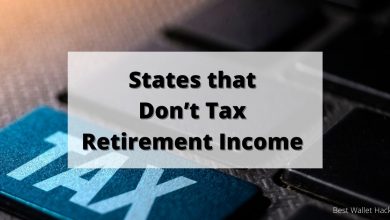Retirement Savings Waterfall: In What Order to Make Your Savings Contributions

The retirement account landscape seems like a mish mash of acronyms – 401(k), IRA, HSA, etc.
If you’re new to this, as I was when I first started working, it can be overwhelming. Fortunately, there is an order of operations when it comes to saving for retirement. And it’s an order that works for everyone, regardless of your income or status.
You may not have access to every type of account on the list but that won’t change the order, you’ll just skip a step. As long as you follow this order of contributions, you’ll be in good shape.
Here it is:
- Contribute to a 401(k) up to the company match
- Contribute to a Traditional or Roth IRA to the annual limits
- Contribute to a Health Savings Account
- Contribute to a 401(k) up to the annual limit
- Contribute to a SEP-IRA
- Contribute to a taxable brokerage account
Remember, you may not have access to each account (or you may have a different type), but if you follow this order you will be in shape.

Table of Contents
1. 401(k) up to match
- 2025 annual contribution limit: $23,500
Many employers offer a retirement account match to incentivize you to save towards retirement. These are defined contribution plans and the most common is a 401(k) and 403(b), which is for non-profits and educational institutions.
You will want to contribute as much as you can up to the match. My first employer, Northrop Grumman, offered a 50% match on the first 6% of contributions. This meant that by contributing 6% of my salary, Northrop Grumman kicked in an additional 3%.
Be sure to review the vesting period if you intend to change jobs. A vesting period is how long you have to wait before the employer match is yours to keep. Your contributions are always yours to keep.
2. Traditional or Roth IRA
📝 The IRS defines an IRA as an Individual Retirement Arrangement but everyone calls it an Individual Retirement Account, which is what I’ll be doing throughout this article. It’s a difference without a distinction.
- 2025 annual contribution limit: $7,000
- 2025 catch-up contribution for ages 50+: $1,000
After the 401(k) and the free money, you will want to contribute to an Individual Retirement Account (IRA). It comes in two flavors:
- Traditional IRA – Contributions are tax deductible and the account grows tax free but you are taxed when you withdraw funds in retirement.
- Roth IRA – Contributions are not tax deductible (after tax) and the account grows tax free and you are not taxed when you withdraw funds in retirement.
Each type has an annual limit, which is shared, and there are also contribution limits based on your income.
You will have to determine which is best for you but the Roth IRA is a very attractive account because it grows tax free and is not taxed when you withdraw funds in retirement.
3. Health Savings Account
- 2025 annual contribution limit (individual): $4,300
- 2025 annual contribution limit (family): $8,550
If you have a high deductible health insurance plan, you can contribute to a Health Savings Account (HSA). An HSA is essentially an investment account with tax benefits when used for medical expenses. Also, some employers will offer a match on contributions into an HSA but this limits what you can contribute since employer and employee contributions count towards the annual limit (but that’s OK, since you don’t pay for employer contributions!).
The beauty of the HSA is that it has a “triple tax benefit:”
- Your contributions are pre-tax – You make them through a payroll deduction and so, like a 401(k) contribution, you aren’t taxed on the dollars you put into the HSA
- It grows tax free – Much like a 401(k) and IRA, it grows tax free.
- Withdrawals are tax free if used for qualified medical expenses – This is what makes HSAs special. You can make withdrawals at any time and those withdrawals are tax free if used for qualified medical expenses.
And if you reach 65 and haven’t used up your funds for medical expenses, it now works just like an IRA.
There is just one hitch – you are subject to the investment options offered by your plan administrator. Most plans will let you invest the money in the account but they do vary, just like 401(k) plans. There are also plan fees but the best HSA plans are modest in this regard.
Depending on your options, you may decide that the HSA is less appealing and skip ahead to #4.
4. Maximize your 401(k)
2025 annual contribution limit: $23,500
Once you’ve contributed the maximum into an IRA, your contributions should be directed back towards your 401(k) plan. The limits on this are often quite high and while you don’t gain any additional employer match, it represents a way for your accounts to grow tax free until retirement.
5. SEP-IRA
- 2025 annual contribution limit: $70,000 (or 25% of employee compensation, whichever is less)
If you have self-employment income, you can, as an employer, make contributions to a simplified employee pension (SEP) IRA. The SEP-IRA is a retirement plan for a small business’s owner and employees and you’re only able to contribute to it if you have business income, which includes self-employment income.
Tax-wise, it’s very similar to a Traditional IRA – contributions are tax deductible and growth is tax deferred. Withdrawals from a SEP-IRA in retirement are taxed as ordinary income. And finally, if you contribute to a traditional IRA, your contribution limit to the SEP-IRA is reduced by the amount you contributed into the traditional IRA.
The big difference to understand with a SEP-IRA is that employees do not contribute to it – only employers make contributions. In the case where you are self-employed, it’s an accounting distinction since you are both employer and employee. It gets tricky if you have employees (since the employer must make the same contribution for all employees) so I’d talk to an accountant for help if this describes you.
The big benefit here is that it’s a way to defer taxation on a lot of income since the limit for a SEP-IRA is quite high.
6. Taxable Brokerage Account
Congratulations! If you’ve gone this far, you have reached the Final Boss for retirement savings.
If you’ve maximized your contributions to all the other accounts, you only have one option left – a taxable brokerage account. There’s nothing particularly special about this category of account other than it’s the only one available.
Each of the prior options had tax benefits and a taxable brokerage account has none. Your contributions are not tax deductible, your investments do not grow tax free (unless you simply hold them), and your withdrawals are subject to long term of short term capital gains tax depending on how well they’ve done. Your starting capital is not taxed though, but contributions were not tax deductible so this should come as no surprise.
Other Posts You May Enjoy:
Summer Reading Programs for Kids 2025
Our kids’ school sent out a list of summer reading programs that we’ll look to get our kids involved in. It’s great that so many books stores and organizations are getting in on the action that was once the domain of Pizza Hut and their Book It program!
Why Saving The First $10,000 Is Critical
Famed investor Charlie Munger has said that saving your first $10,000 is the hardest but also the most important. If you don’t save and invest your money, you will forever have to trade your time for more money – see why this makes so much sense.
Major Banks with ATM Fee Reimbursement
If you’re paying ATM fees to your bank for accessing your money, you should switch banks immediately. There are many banks that offer ATM reimbursement, sometimes unlimited, as well as a high interest rate.
How to Earn Airline Miles and Hotel Points without a Credit Card
We know the best way to earn airline miles and hotel points is by getting their credit card, but what can you do beyond that? What strategies can you use to earn more so you can take that dream vacation?

About Jim Wang
Jim Wang is a forty-something father of four who is a frequent contributor to Forbes and Vanguard’s Blog. He has also been fortunate to have appeared in the New York Times, Baltimore Sun, Entrepreneur, and Marketplace Money.
Jim has a B.S. in Computer Science and Economics from Carnegie Mellon University, an M.S. in Information Technology – Software Engineering from Carnegie Mellon University, as well as a Masters in Business Administration from Johns Hopkins University. His approach to personal finance is that of an engineer, breaking down complex subjects into bite-sized easily understood concepts that you can use in your daily life.
One of his favorite tools (here’s my treasure chest of tools, everything I use) is Empower Personal Dashboard, which enables him to manage his finances in just 15-minutes each month. They also offer financial planning, such as a Retirement Planning Tool that can tell you if you’re on track to retire when you want. It’s free.
Opinions expressed here are the author’s alone, not those of any bank or financial institution. This content has not been reviewed, approved or otherwise endorsed by any of these entities.




